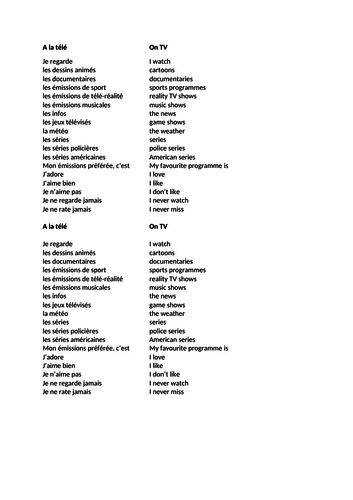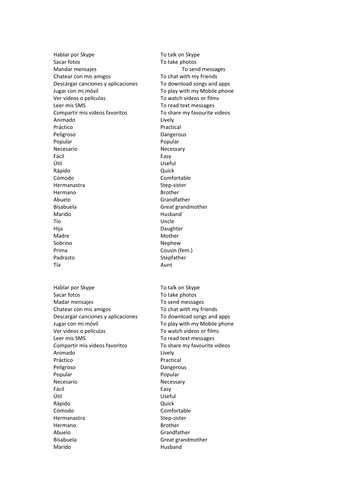
3k+Uploads
493k+Views
178k+Downloads
All resources

L’Étranger - Albert Camus - Practice Essay Titles
This resource includes 100 practice essay titles for L’Étranger by Albert Camus.

L’Étranger - Albert Camus - Key Vocabulary - A Level French
This is a French to English glossary of key vocabulary students need to be able to discuss L’Étranger by Albert Camus. The glossary is separated into 8 categories.

L’Étranger - Albert Camus - Themes: The Meaning of Life and Death - A Level French
This text is a literary analysis of L’Étranger by Albert Camus in French, focusing on the themes of life and death in the form of a gap-fill exercise. It contains answers at the end.

Studio 2 (Rouge) - Module 1 - La télé (Pages 8 - 9)
These resources are designed to accompany Studio 2 (Rouge) - Module 1 - La tele (Pages 8 - 9). They introduce, practise and consolidate the vocabulary and grammar points for this double-page spread and feature additional resources.
If you find this useful, please leave a review :)

GCSE French Speaking Examination Booklet and Resources (2016 Specification)
These resources are designed for the general conversation part of the GCSE French speaking examination and include :
A booklet with questions for each Module.
Five sample answers for each question to support students in writing their own answers.
There are three booklets of sample answers. One for Foundation students (Grades 1-4), Intermediate students (Grades 3-6) and Higher (Grades 7-9)
There are also a Foundation and Higher booklet with useful vocabulary and structures for each question.

AQA / EDEXCEL Viva GCSE Spanish (Higher) - Modulo 3 - Punto de partida 1 - Page 50
This is a complete lesson which is designed to be taught alongside AQA / EDEXCEL Viva GCSE Spanish (Higher) - Modulo 3 - Punto de partida 1 - Page 50.
If you like the resources, please leave a review :)

AQA / EDEXCEL Viva GCSE Spanish (Higher) - Modulo 3 - Punto de partida 1 - Page 51
This is a complete lesson which is designed to be used along with AQA / EDEXCEL Viva GCSE Spanish (Higher) - Modulo 3 - Punto de partida 1 - Page 51.
If you like this resource, please leave a review :)

Studio 3 (Vert) - Module 1 - Fou de musique! - Grammar - Using on in the Perfect Tense
French Grammar: Using on in the Perfect Tense
This printable worksheet is designed to help learners of French practise using the subject pronoun on in the perfect tense.
It introduces regular past participles and highlights how verbs like aller change, including the agreement rules for all-female groups.
The worksheet is also available as a PowerPoint presentation for classroom use or digital learning.
Key features:
Simple, age-appropriate explanation of how on means “we” and how to use it in the perfect tense
Clear guidance on using on est allé(e)(s) with the verb aller
Six varied activities to reinforce understanding, including matching, gap-fill, sentence writing, and true or false questions
Full answer key provided for easy marking or self-assessment

Using on in the Perfect Tense
French Grammar: Using on in the Perfect Tense
This printable worksheet is designed to help learners of French practise using the subject pronoun on in the perfect tense.
It introduces regular past participles and highlights how verbs like aller change, including the agreement rules for all-female groups.
The worksheet is also available as a PowerPoint presentation for classroom use or digital learning.
Key features:
Simple, age-appropriate explanation of how on means “we” and how to use it in the perfect tense
Clear guidance on using on est allé(e)(s) with the verb aller
Six varied activities to reinforce understanding, including matching, gap-fill, sentence writing, and true or false questions
Full answer key provided for easy marking or self-assessment

Studio 3 (Vert) - Module 2 - Touché - Grammar - Using à with the Definite Article
French Grammar: Using à with the Definite Article (au, à la, à l’, aux)
This printable worksheet is designed to help learners of French practise using à followed by the definite article, including the forms au, à la, à l’ and aux.
It focuses on how these forms are used when talking about places and parts of the body.
The worksheet is also available as a PowerPoint presentation.
Key features:
Simple, age-appropriate explanation of à + le / la / l’ / les
Clear examples showing how to use these forms with everyday vocabulary
Six varied activities to reinforce understanding, including matching, sentence completion, multiple choice, and personal response
Full answer key provided for easy marking or self-assessment

Using à with the Definite Article (au, à la, à l’, aux)
French Grammar: Using à with the Definite Article (au, à la, à l’, aux)
This printable worksheet is designed to help learners of French practise using à followed by the definite article, including the forms au, à la, à l’ and aux.
It focuses on how these forms are used when talking about places and parts of the body.
The worksheet is also available as a PowerPoint presentation.
Key features:
Simple, age-appropriate explanation of à + le / la / l’ / les
Clear examples showing how to use these forms with everyday vocabulary
Six varied activities to reinforce understanding, including matching, sentence completion, multiple choice, and personal response
Full answer key provided for easy marking or self-assessment

Viva 1 - Module 1 - ÂżTienes hermanos? - Asking about and telling your age
¿Cuántos años tienes? – Tengo… años
This printable worksheet is designed to help learners of Spanish practise asking and answering about age using the question ¿Cuántos años tienes? and the structure Tengo… años.
It focuses on numbers from one to fifteen and includes a clear grammar point.
The worksheet is also available as a PowerPoint presentation for use in class or at home.
Key features:
Simple, age-appropriate explanation of how to ask and answer questions about age in Spanish
Clear vocabulary list of numbers from uno to quince with English translations
Six varied activities to reinforce understanding, including matching, sentence completion, translation, and number recognition
Full answer key provided for easy marking or self-assessment

¿Cuántos años tienes? – Tengo… años
¿Cuántos años tienes? – Tengo… años
This printable worksheet is designed to help learners of Spanish practise asking and answering about age using the question ¿Cuántos años tienes? and the structure Tengo… años.
It focuses on numbers from one to fifteen and includes a clear grammar point.
The worksheet is also available as a PowerPoint presentation for use in class or at home.
Key features:
Simple, age-appropriate explanation of how to ask and answer questions about age in Spanish
Clear vocabulary list of numbers from uno to quince with English translations
Six varied activities to reinforce understanding, including matching, sentence completion, translation, and number recognition
Full answer key provided for easy marking or self-assessment

Studio 3 (Vert) - Qu'est-ce que tu as fait samedi? - Grammar - Describing What Other People Did
French Grammar: Talking About What Someone Did (Passé Composé)
This printable worksheet is designed to help learners of French practise using the passé composé with avoir and être, focusing on saying what someone else did using il/elle a and il/elle est allé(e).
The worksheet is also available as a PowerPoint presentation for classroom or online use.
Key features:
Simple, age-appropriate explanation of how to use il and elle with common verbs in the past tense
Clear introduction to the use of ĂŞtre with aller
Six varied activities to reinforce understanding, including sentence matching, gap-fill, verb choice, and translation
Full answer key provided for easy marking or self-assessment

Studio 3 (Vert) - Module 1 - Tu veux y aller? - Grammar - Aller
French Grammar: The Verb Aller in the Present Tense (je, tu, il/elle/on)
This printable worksheet is designed to help learners of French practise using the present tense of the irregular verb aller with the subject pronouns je, tu, il/elle/on.
The resource uses child-friendly language, emojis, and varied tasks to support comprehension and engagement.
Key features:
Simple, age-appropriate explanation of je, tu, il/elle/on with the verb aller
Six varied activities to reinforce learning, including gap-fill, matching, sentence ordering, and sentence creation
Use of emojis to support understanding and visual learning
Full answer key provided for quick marking or independent checking

Studio 3 (Vert) - Module 1 - Qu'est-ce que tu as fait samedi? - Grammar - Perfect Tense
French Grammar: The Perfect Tense with j’ai and je suis
This printable worksheet is designed to support young learners of French in understanding how to use the perfect tense to talk about past actions.
It introduces the use of j’ai with regular past participles and je suis allé(e) for movement verbs such as aller.
The worksheet is also available as a PowerPoint presentation for classroom use or remote learning.
Key features:
Clear, age-appropriate explanation of how to form the perfect tense using j’ai and je suis
Simple introduction to the difference between j’ai regardé and je suis allé(e)
Six engaging activities including matching, gap-fill, sentence building, and translation
Visual support using emojis to aid comprehension and retention
Full answer key included for easy marking or independent checking

The Perfect Tense with Il and Elle
French Grammar: Talking About What Someone Did (Passé Composé)
This printable worksheet is designed to help learners of French practise using the passé composé with avoir and être, focusing on saying what someone else did using il/elle a and il/elle est allé(e).
The worksheet is also available as a PowerPoint presentation for classroom or online use.
Key features:
Simple, age-appropriate explanation of how to use il and elle with common verbs in the past tense
Clear introduction to the use of ĂŞtre with aller
Six varied activities to reinforce understanding, including sentence matching, gap-fill, verb choice, and translation
Full answer key provided for easy marking or self-assessment

Tener (present, singular)
Spanish Grammar: tener (present, singular)
This printable worksheet is designed to help learners of Spanish practise using the verb tener in the present tense (singular forms).
It supports understanding of subject–verb agreement with yo, tú, él, ella, and usted. The worksheet is also available as a PowerPoint presentation.
Key features:
Simple, age-appropriate explanation of how to use tener with singular subject pronouns
Clear layout to support early grammar learning and sentence formation
Six varied activities to reinforce understanding, including gap-fill, matching, sentence writing, and multiple choice
Full answer key provided for easy marking or self-assessment

Viva 1 - ÂżTienes hermanos? - Grammar - Tener (present, singular)
Spanish Grammar: tener (present, singular)
This printable worksheet is designed to help learners of Spanish practise using the verb tener in the present tense (singular forms).
It supports understanding of subject–verb agreement with yo, tú, él, ella, and usted. The worksheet is also available as a PowerPoint presentation.
Key features:
Simple, age-appropriate explanation of how to use tener with singular subject pronouns
Clear layout to support early grammar learning and sentence formation
Six varied activities to reinforce understanding, including gap-fill, matching, sentence writing, and multiple choice
Full answer key provided for easy marking or self-assessment

Studio 3 (Vert) - Module 1 - Planète Facebook - Grammar - Present tense (-er verbs and faire)
French Grammar Worksheet: je, tu, il/elle with -ER Verbs and faire
This printable worksheet is designed to help learners of French practise using the subject pronouns je, tu, il/elle with regular -ER verbs in the present tense, as well as the irregular verb faire.
The worksheet is also available as a PowerPoint presentation for classroom or remote teaching.
Key features:
Simple, age-appropriate explanation of how to use je, tu, il/elle with -ER verbs
Clear introduction to the irregular verb faire in the present tense
Six varied activities to reinforce understanding, including matching, gap-fill, multiple choice, and translation
Full answer key provided for easy marking or self-assessment




















